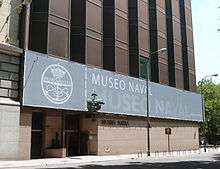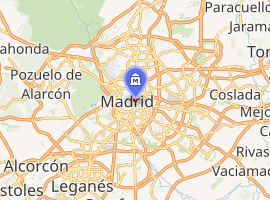Naval Museum of Madrid
The Museo Naval de Madrid —in English, Naval Museum of Madrid— is a national museum in Madrid, Spain. It shows the history of the Spanish Navy since the Catholic Monarchs, in the 15th century, up to the present. The displays set naval history in a wide context with information about Spanish rulers and the country's former colonies. The collections include navigation instruments, weapons, maps and paintings.
 | |
 | |

| |
| Established | 1843 |
|---|---|
| Location | Paseo del Prado 5 Madrid, Spain |
| Coordinates | 40.417456°N 3.692804°W |
| Type | Naval museum |
| Website | www.armada.mde.es/museonaval |
The building
Its origins date back to 1792, but it was not until 1843 when the Museum was inaugurated in Madrid. The then Spanish Naval Ministry was provided with a new headquarters in the 1920s, and the museum moved there in 1932. (Until 1977 there were three ministerial portfolios, one for each of the different branches of the Armed Forces: the army, navy, and air force. During the Transición, Adolfo Suárez combined them into one). The architects were José Espelius and Francisco Javier de Luque.
Visitors enter the museum through a modernist facade on the Paseo del Prado, and pass to the first floor where former courtyards (now exhibition halls of the Naval Museum) are covered by spectacular stained-glass roofs with naval and decorative motifs made by Maumejean (a family glass-making business which had a branch in Spain). At weekends a doorway onto the grand staircase of Navy Headquarters is opened to allow visitors to appreciate the architecture.[2]
Collections
The map of Juan de la Cosa, the earliest preserved map of the Americas,[3] is on permanent display in this museum.
Since 2007 the museum has hosted a specimen of moon rock. One of two such samples given to Spain, it was collected on the 1972 Apollo 17 mission. The rock, which weighs one gram, was put on display in 2009, to mark the 40th anniversary of the first moon landing.[4]
See also
References
- "Abre al público la escalera más bonita de Madrid". ABC (in Spanish).
- Robles, Luis A. "Juan de la Cosa's Projection: A Fresh Analysis of the Earliest Preserved Map of the Americas". Archived from the original on 18 October 2017. Retrieved 15 May 2012.
- It was put on display as part of a Nuit Blanche. See "La piedra lunar que EEUU regaló a España, estrella de la 'Noche en Blanco' de Madrid". El Mundo. September 2009. Retrieved 3 November 2012.
External links
| Wikimedia Commons has media related to Museo Naval, Madrid. |
- Pictures of ship models in the museum, from visit in May 2009 High resolution photos